DODGE JOURNEY 2010 1.G Owners Manual
Manufacturer: DODGE, Model Year: 2010, Model line: JOURNEY, Model: DODGE JOURNEY 2010 1.GPages: 512
Page 101 of 512
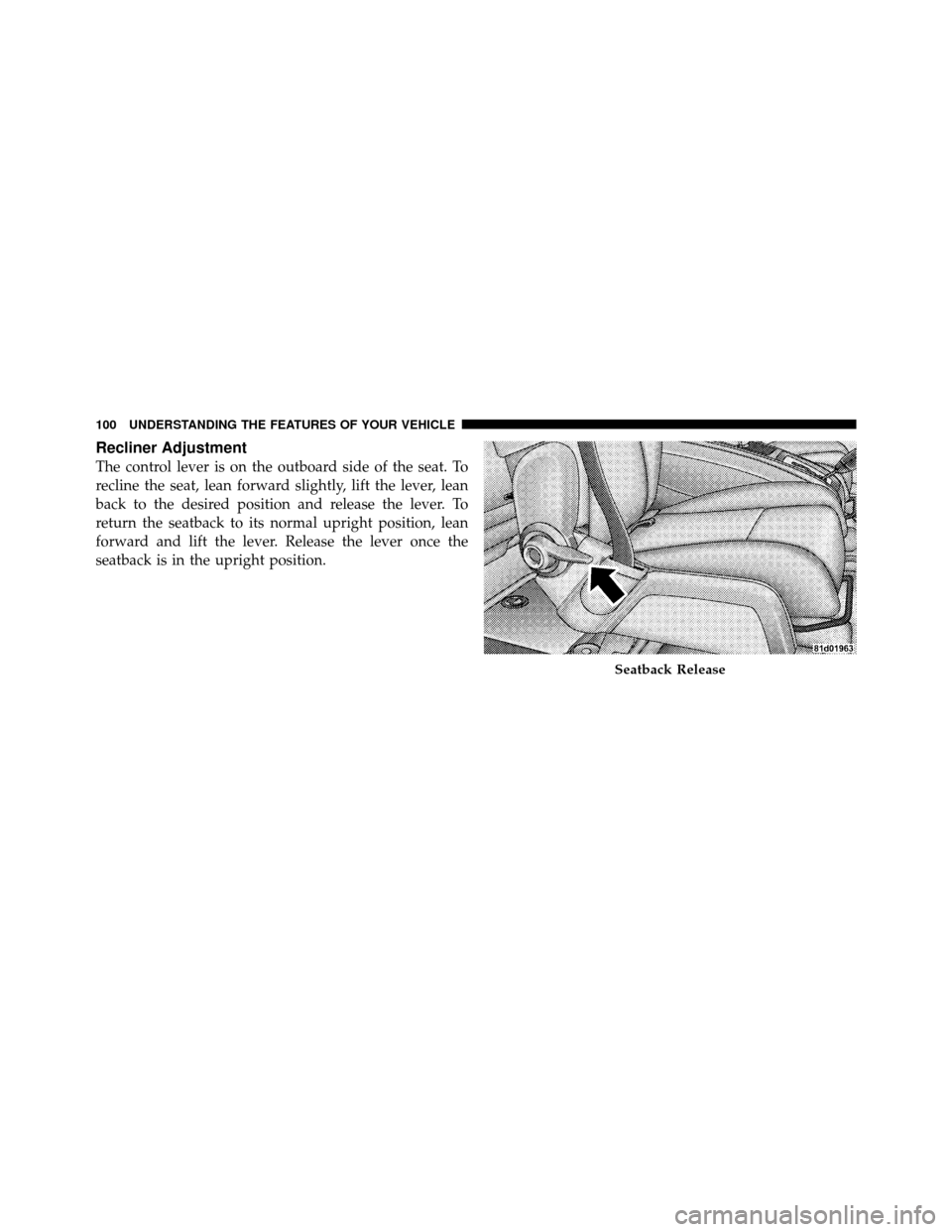
Recliner Adjustment
The control lever is on the outboard side of the seat. To
recline the seat, lean forward slightly, lift the lever, lean
back to the desired position and release the lever. To
return the seatback to its normal upright position, lean
forward and lift the lever. Release the lever once the
seatback is in the upright position.
Seatback Release
100 UNDERSTANDING THE FEATURES OF YOUR VEHICLE
Page 102 of 512
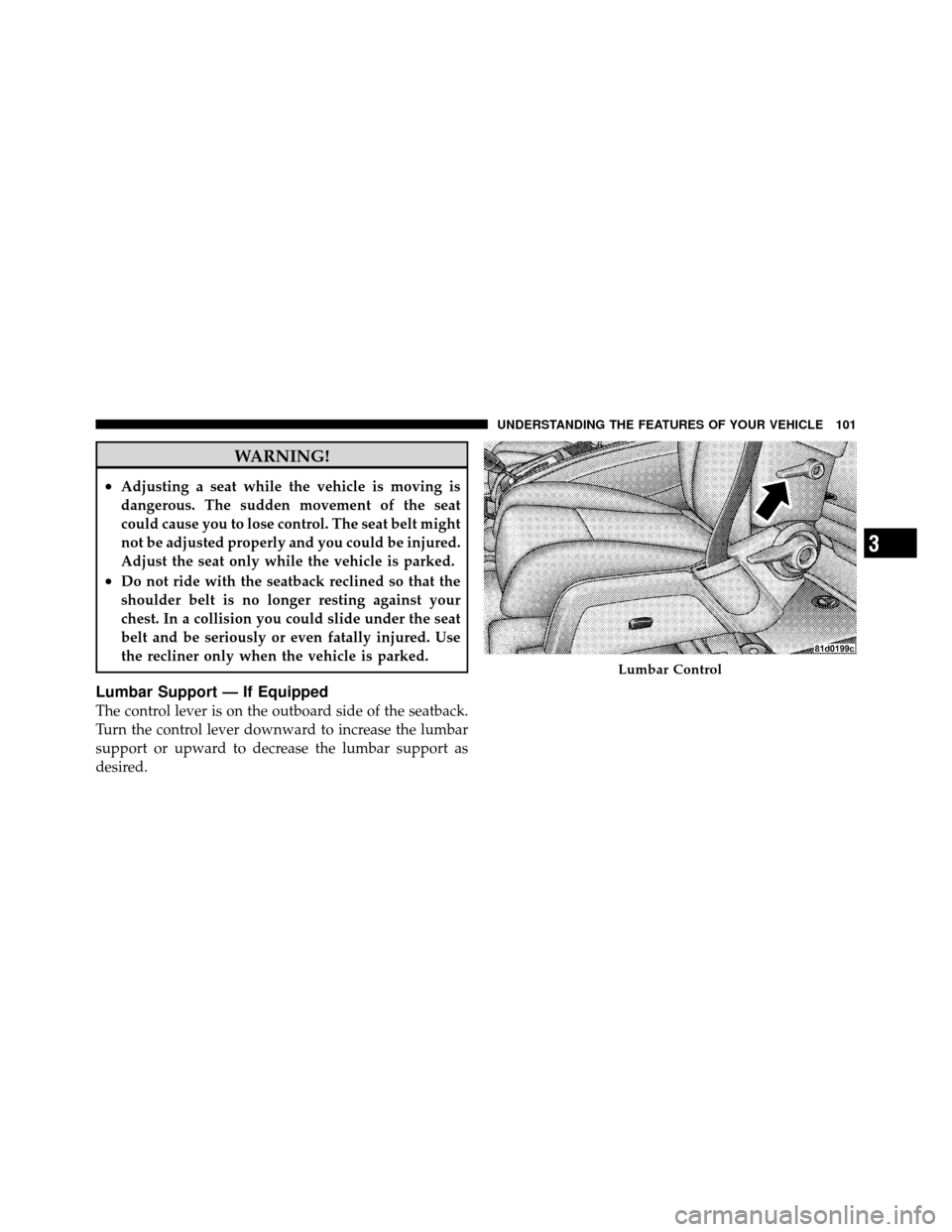
WARNING!
•Adjusting a seat while the vehicle is moving is
dangerous. The sudden movement of the seat
could cause you to lose control. The seat belt might
not be adjusted properly and you could be injured.
Adjust the seat only while the vehicle is parked.
•Do not ride with the seatback reclined so that the
shoulder belt is no longer resting against your
chest. In a collision you could slide under the seat
belt and be seriously or even fatally injured. Use
the recliner only when the vehicle is parked.
Lumbar Support — If Equipped
The control lever is on the outboard side of the seatback.
Turn the control lever downward to increase the lumbar
support or upward to decrease the lumbar support as
desired.
Lumbar Control
3
UNDERSTANDING THE FEATURES OF YOUR VEHICLE 101
Page 103 of 512
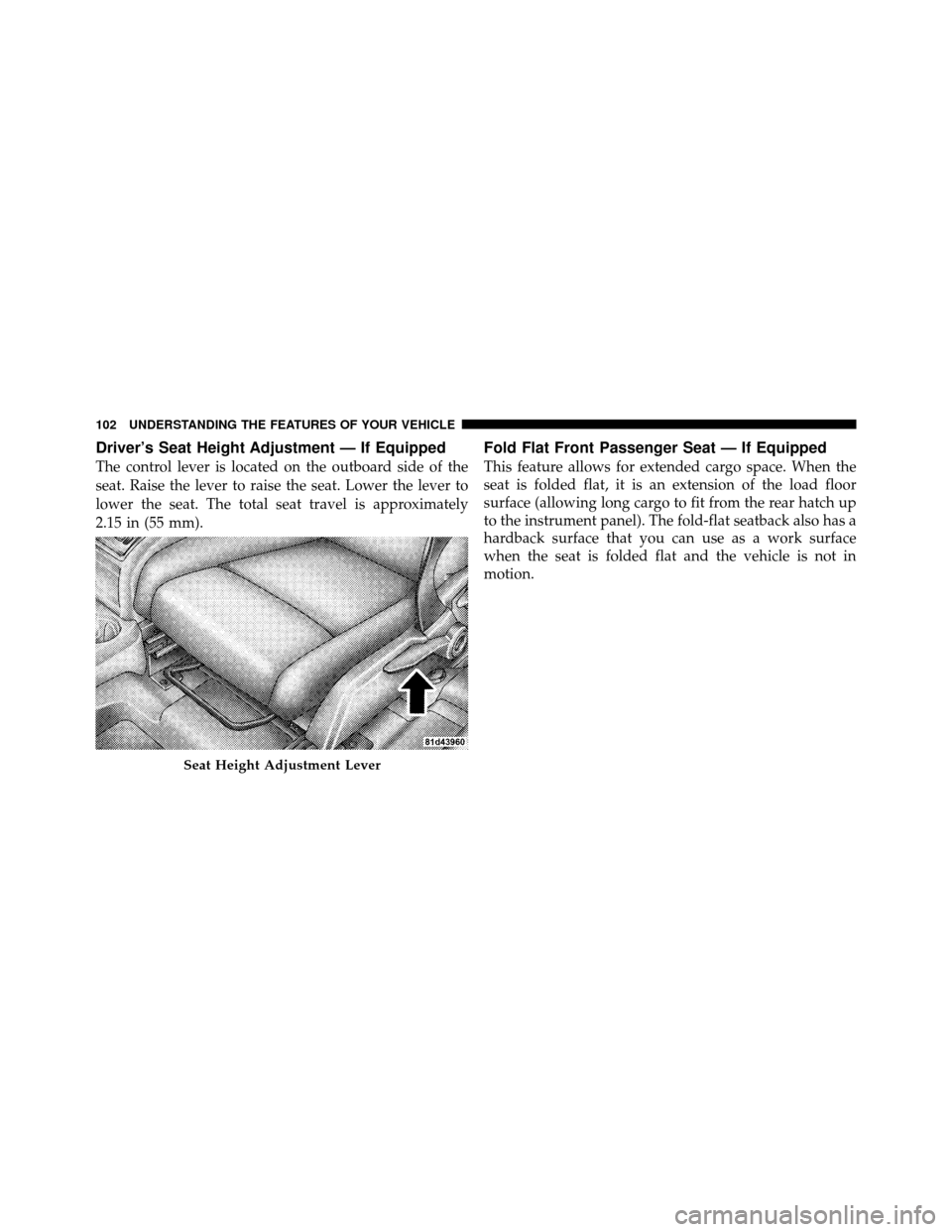
Driver’s Seat Height Adjustment — If Equipped
The control lever is located on the outboard side of the
seat. Raise the lever to raise the seat. Lower the lever to
lower the seat. The total seat travel is approximately
2.15 in (55 mm).
Fold Flat Front Passenger Seat — If Equipped
This feature allows for extended cargo space. When the
seat is folded flat, it is an extension of the load floor
surface (allowing long cargo to fit from the rear hatch up
to the instrument panel). The fold-flat seatback also has a
hardback surface that you can use as a work surface
when the seat is folded flat and the vehicle is not in
motion.
Seat Height Adjustment Lever
102 UNDERSTANDING THE FEATURES OF YOUR VEHICLE
Page 104 of 512
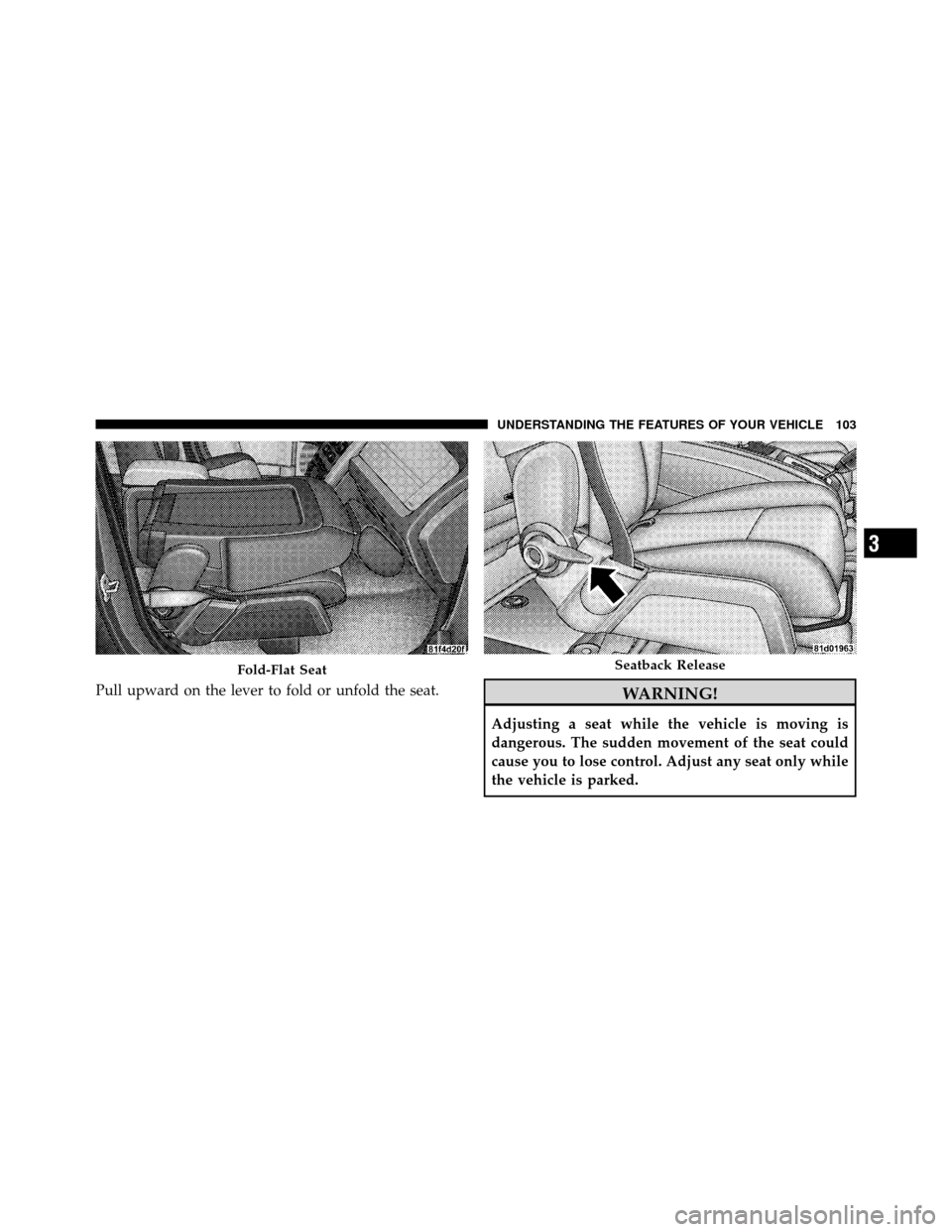
Pull upward on the lever to fold or unfold the seat.WARNING!
Adjusting a seat while the vehicle is moving is
dangerous. The sudden movement of the seat could
cause you to lose control. Adjust any seat only while
the vehicle is parked.
Fold-Flat SeatSeatback Release
3
UNDERSTANDING THE FEATURES OF YOUR VEHICLE 103
Page 105 of 512
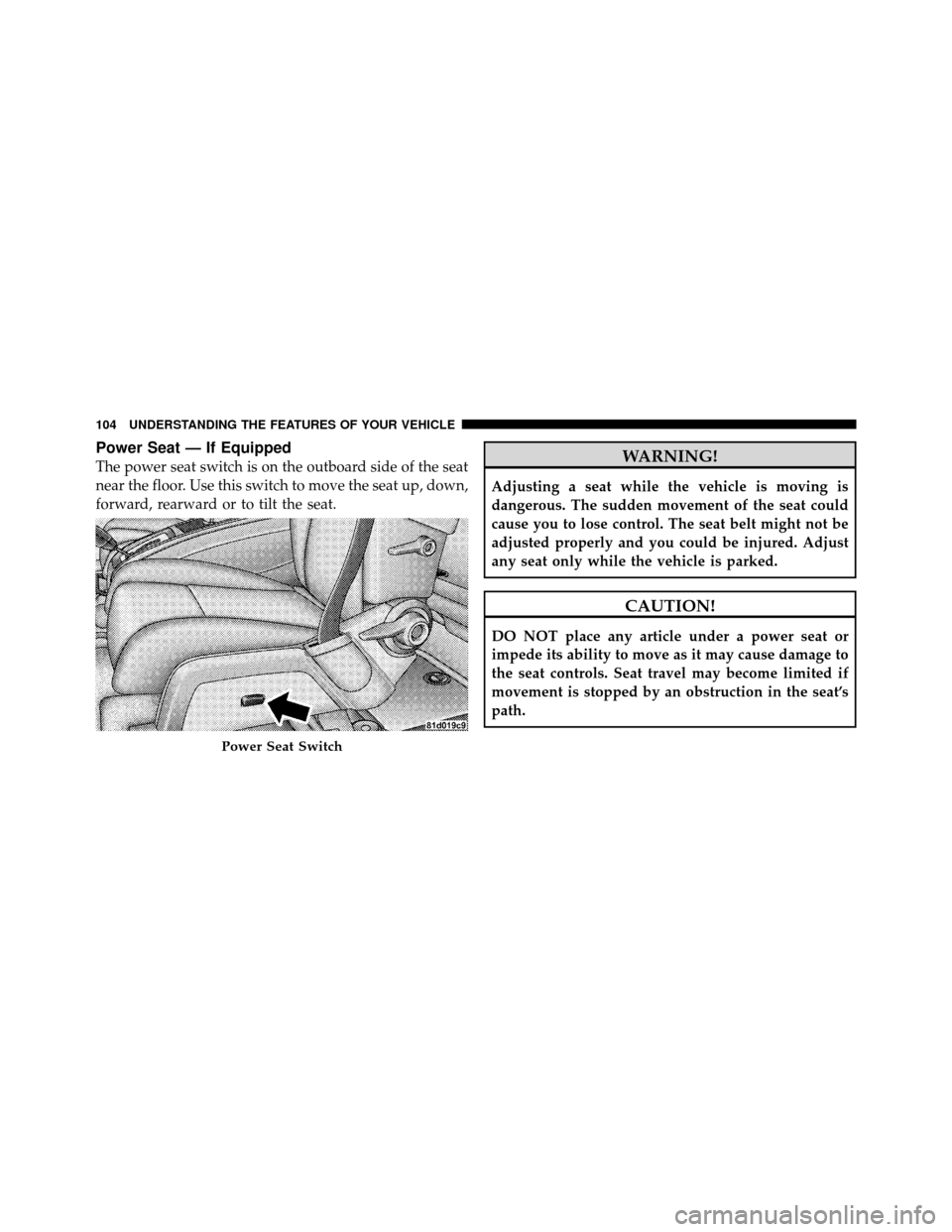
Power Seat — If Equipped
The power seat switch is on the outboard side of the seat
near the floor. Use this switch to move the seat up, down,
forward, rearward or to tilt the seat.WARNING!
Adjusting a seat while the vehicle is moving is
dangerous. The sudden movement of the seat could
cause you to lose control. The seat belt might not be
adjusted properly and you could be injured. Adjust
any seat only while the vehicle is parked.
CAUTION!
DO NOT place any article under a power seat or
impede its ability to move as it may cause damage to
the seat controls. Seat travel may become limited if
movement is stopped by an obstruction in the seat’s
path.
Power Seat Switch
104 UNDERSTANDING THE FEATURES OF YOUR VEHICLE
Page 106 of 512
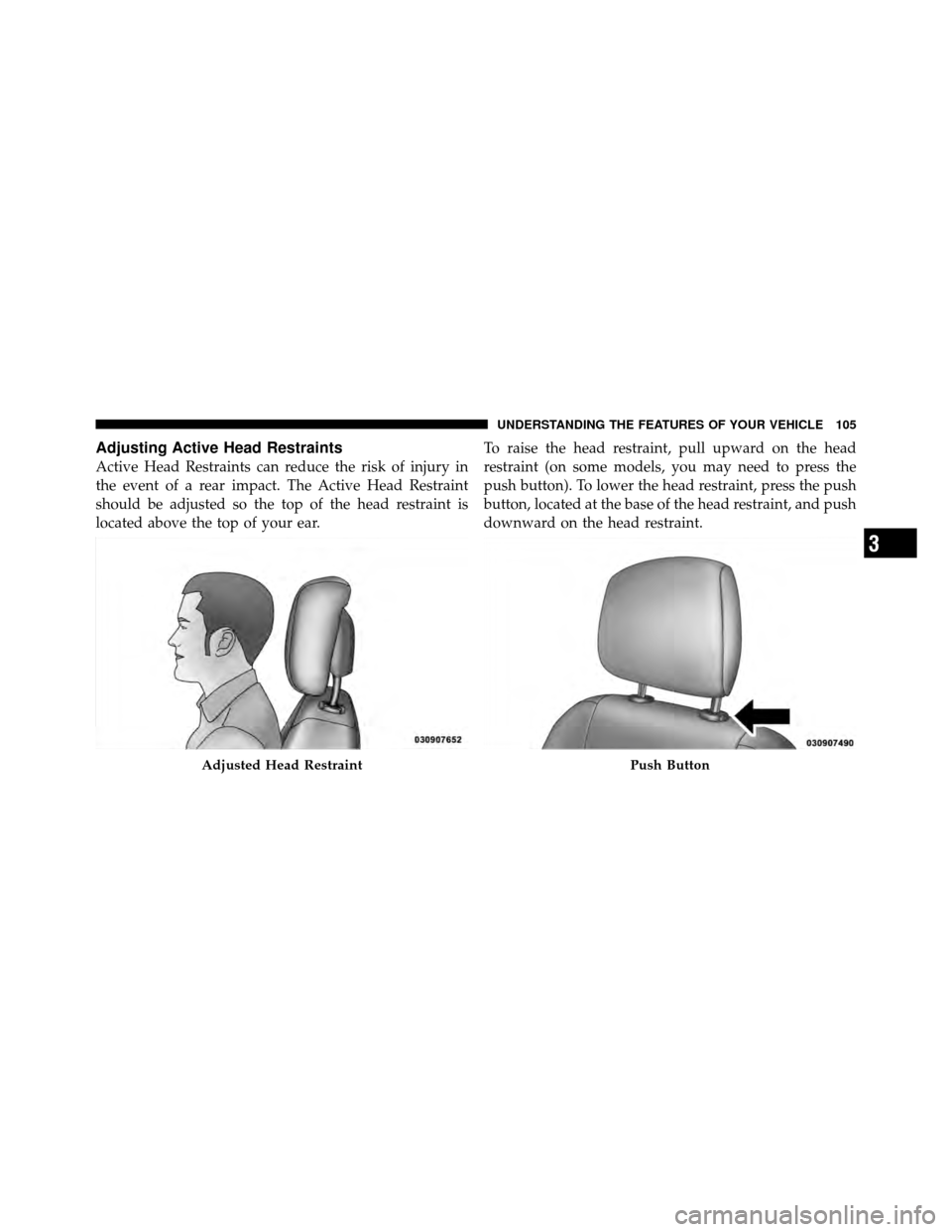
Adjusting Active Head Restraints
Active Head Restraints can reduce the risk of injury in
the event of a rear impact. The Active Head Restraint
should be adjusted so the top of the head restraint is
located above the top of your ear.To raise the head restraint, pull upward on the head
restraint (on some models, you may need to press the
push button). To lower the head restraint, press the push
button, located at the base of the head restraint, and push
downward on the head restraint.
Adjusted Head RestraintPush Button
3
UNDERSTANDING THE FEATURES OF YOUR VEHICLE 105
Page 107 of 512
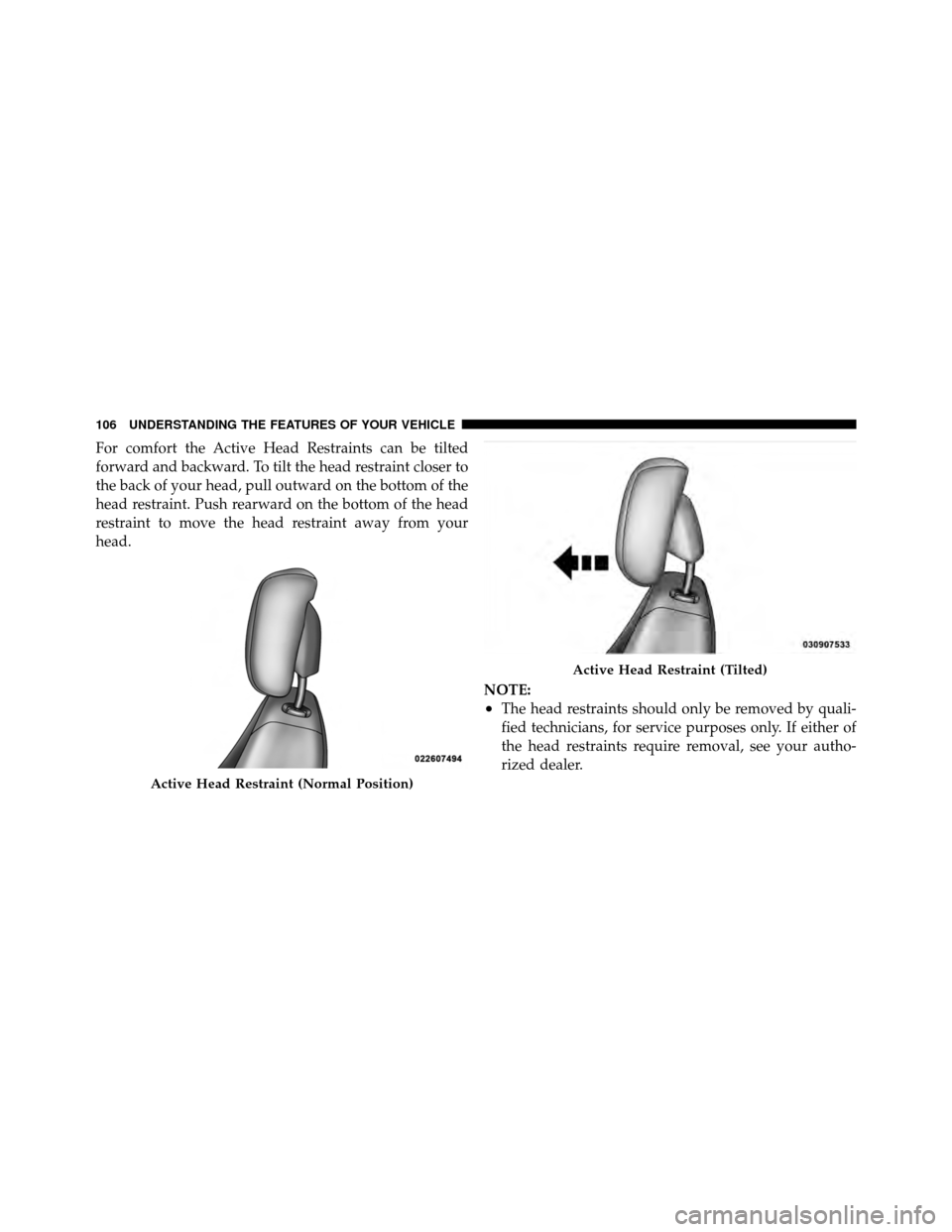
For comfort the Active Head Restraints can be tilted
forward and backward. To tilt the head restraint closer to
the back of your head, pull outward on the bottom of the
head restraint. Push rearward on the bottom of the head
restraint to move the head restraint away from your
head.NOTE:
•The head restraints should only be removed by quali-
fied technicians, for service purposes only. If either of
the head restraints require removal, see your autho-
rized dealer.
Active Head Restraint (Normal Position)
Active Head Restraint (Tilted)
106 UNDERSTANDING THE FEATURES OF YOUR VEHICLE
Page 108 of 512
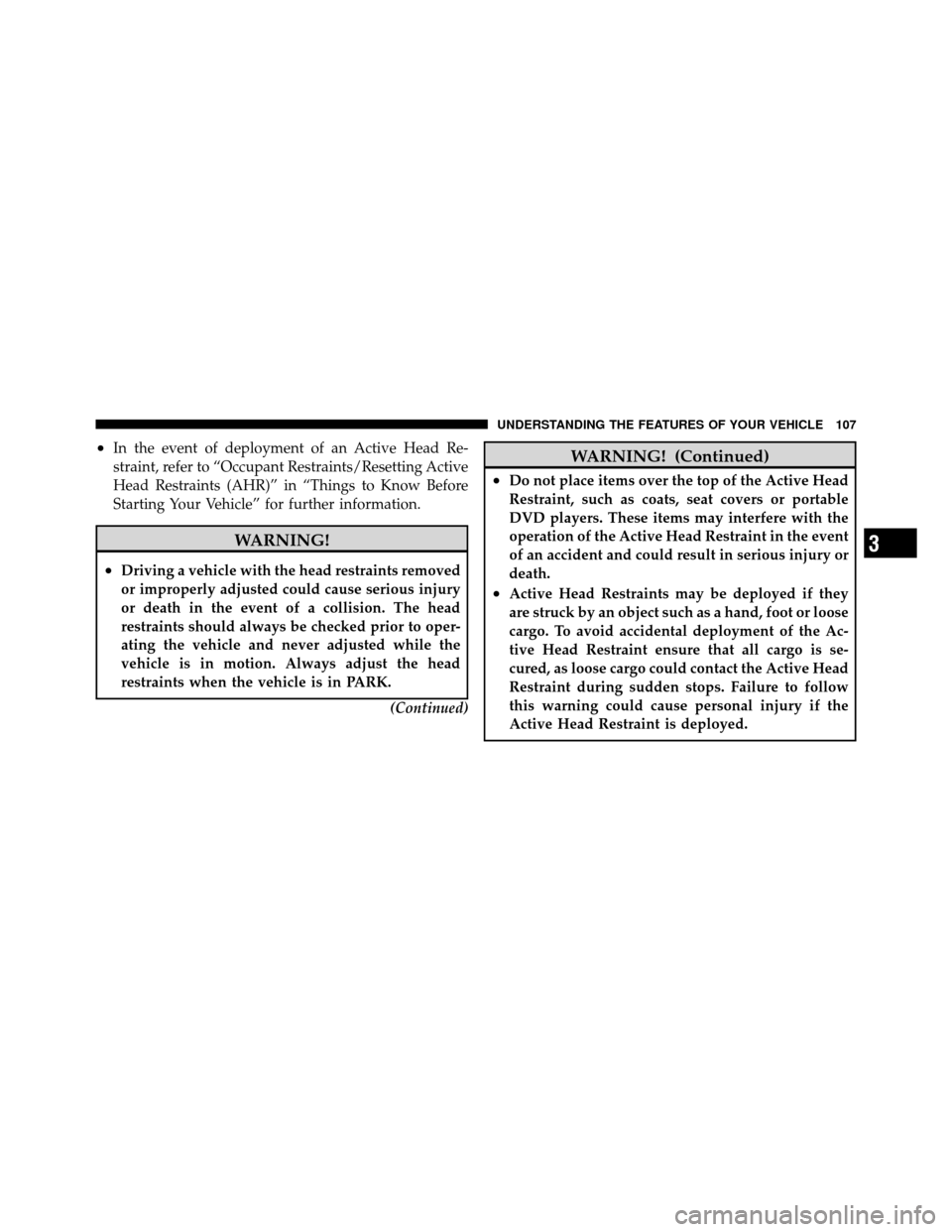
•In the event of deployment of an Active Head Re-
straint, refer to “Occupant Restraints/Resetting Active
Head Restraints (AHR)” in “Things to Know Before
Starting Your Vehicle” for further information.
WARNING!
•Driving a vehicle with the head restraints removed
or improperly adjusted could cause serious injury
or death in the event of a collision. The head
restraints should always be checked prior to oper-
ating the vehicle and never adjusted while the
vehicle is in motion. Always adjust the head
restraints when the vehicle is in PARK.(Continued)
WARNING! (Continued)
•Do not place items over the top of the Active Head
Restraint, such as coats, seat covers or portable
DVD players. These items may interfere with the
operation of the Active Head Restraint in the event
of an accident and could result in serious injury or
death.
•Active Head Restraints may be deployed if they
are struck by an object such as a hand, foot or loose
cargo. To avoid accidental deployment of the Ac-
tive Head Restraint ensure that all cargo is se-
cured, as loose cargo could contact the Active Head
Restraint during sudden stops. Failure to follow
this warning could cause personal injury if the
Active Head Restraint is deployed.
3
UNDERSTANDING THE FEATURES OF YOUR VEHICLE 107
Page 109 of 512
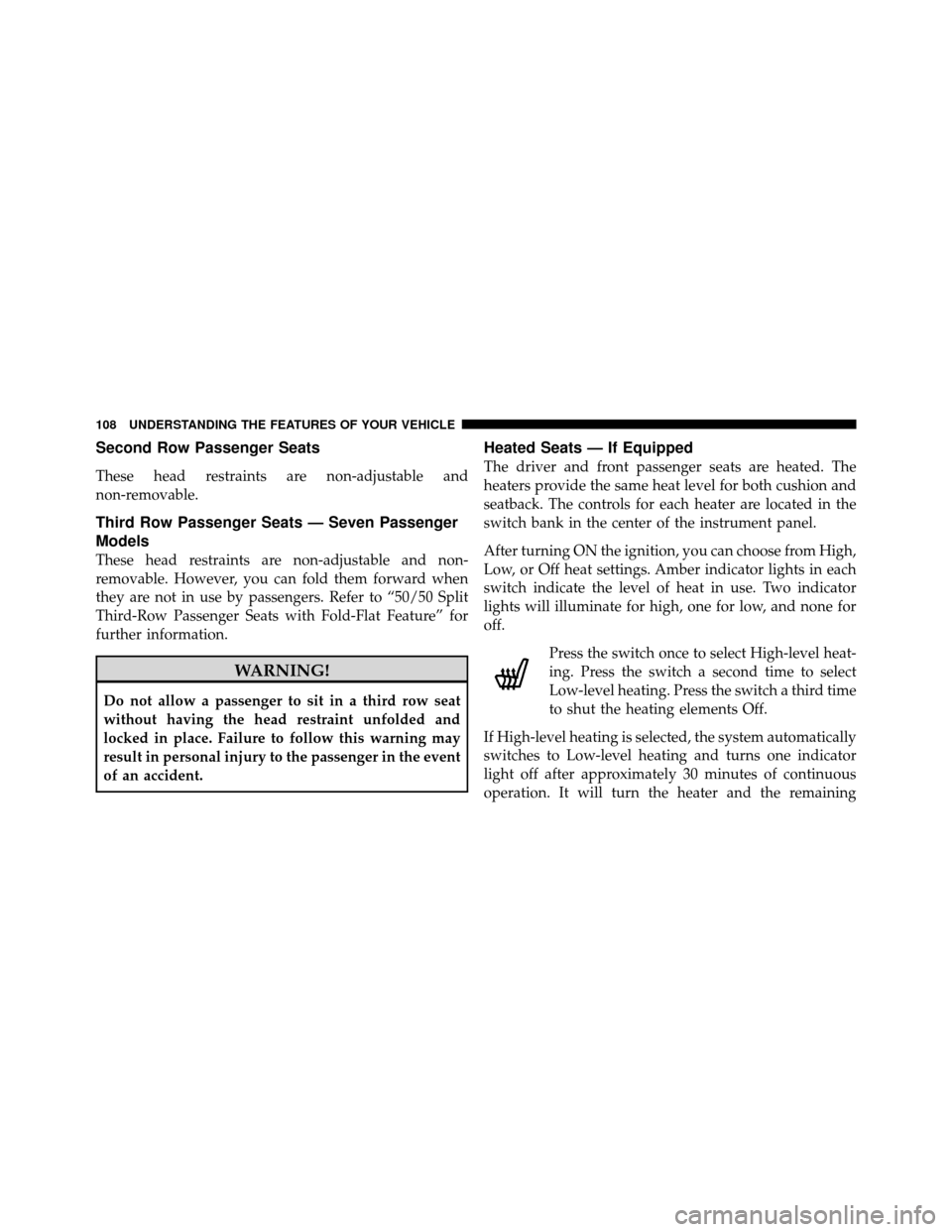
Second Row Passenger Seats
These head restraints are non-adjustable and
non-removable.
Third Row Passenger Seats — Seven Passenger
Models
These head restraints are non-adjustable and non-
removable. However, you can fold them forward when
they are not in use by passengers. Refer to “50/50 Split
Third-Row Passenger Seats with Fold-Flat Feature” for
further information.
WARNING!
Do not allow a passenger to sit in a third row seat
without having the head restraint unfolded and
locked in place. Failure to follow this warning may
result in personal injury to the passenger in the event
of an accident.
Heated Seats — If Equipped
The driver and front passenger seats are heated. The
heaters provide the same heat level for both cushion and
seatback. The controls for each heater are located in the
switch bank in the center of the instrument panel.
After turning ON the ignition, you can choose from High,
Low, or Off heat settings. Amber indicator lights in each
switch indicate the level of heat in use. Two indicator
lights will illuminate for high, one for low, and none for
off.Press the switch once to select High-level heat-
ing. Press the switch a second time to select
Low-level heating. Press the switch a third time
to shut the heating elements Off.
If High-level heating is selected, the system automatically
switches to Low-level heating and turns one indicator
light off after approximately 30 minutes of continuous
operation. It will turn the heater and the remaining
108 UNDERSTANDING THE FEATURES OF YOUR VEHICLE
Page 110 of 512
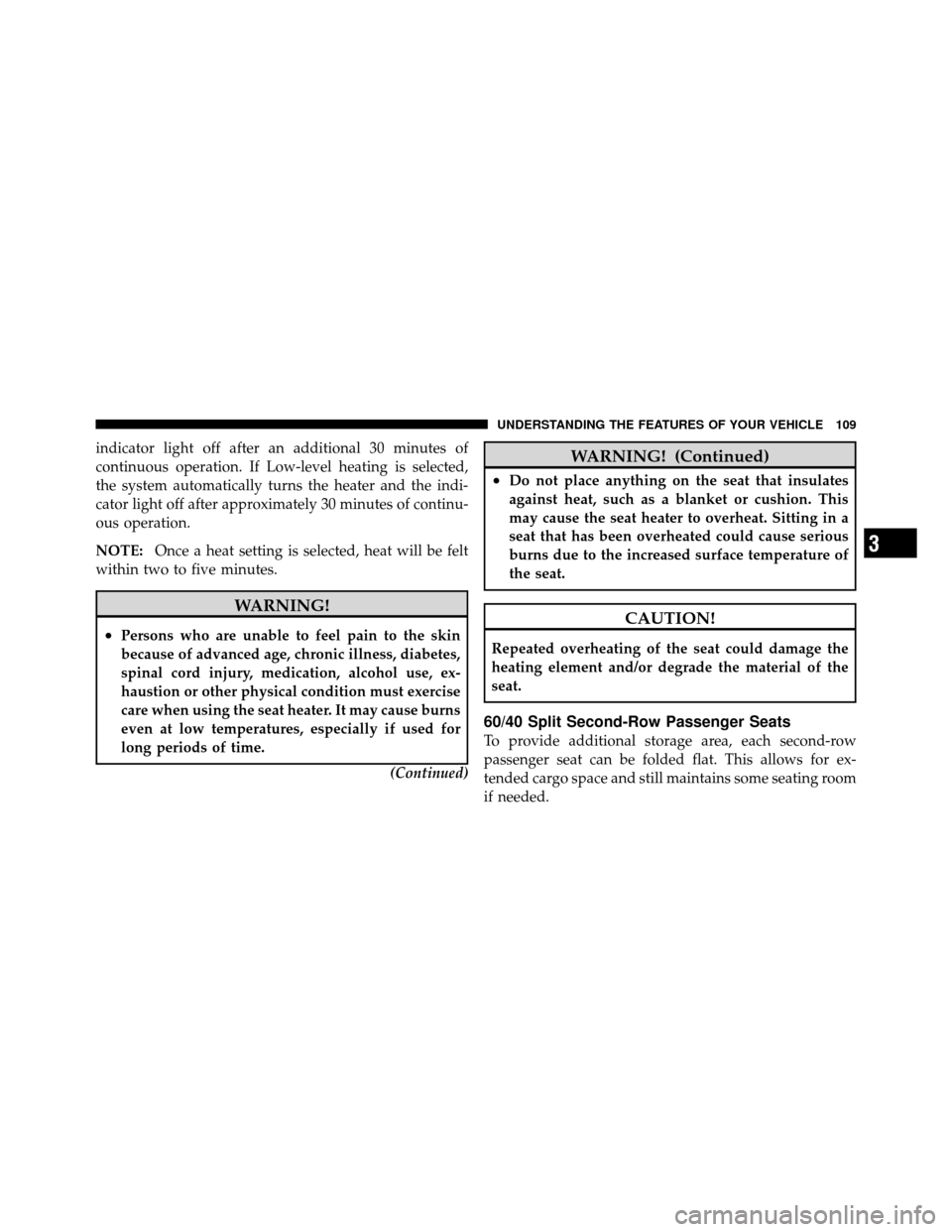
indicator light off after an additional 30 minutes of
continuous operation. If Low-level heating is selected,
the system automatically turns the heater and the indi-
cator light off after approximately 30 minutes of continu-
ous operation.
NOTE:Once a heat setting is selected, heat will be felt
within two to five minutes.
WARNING!
•Persons who are unable to feel pain to the skin
because of advanced age, chronic illness, diabetes,
spinal cord injury, medication, alcohol use, ex-
haustion or other physical condition must exercise
care when using the seat heater. It may cause burns
even at low temperatures, especially if used for
long periods of time.
(Continued)
WARNING! (Continued)
•Do not place anything on the seat that insulates
against heat, such as a blanket or cushion. This
may cause the seat heater to overheat. Sitting in a
seat that has been overheated could cause serious
burns due to the increased surface temperature of
the seat.
CAUTION!
Repeated overheating of the seat could damage the
heating element and/or degrade the material of the
seat.
60/40 Split Second-Row Passenger Seats
To provide additional storage area, each second-row
passenger seat can be folded flat. This allows for ex-
tended cargo space and still maintains some seating room
if needed.
3
UNDERSTANDING THE FEATURES OF YOUR VEHICLE 109